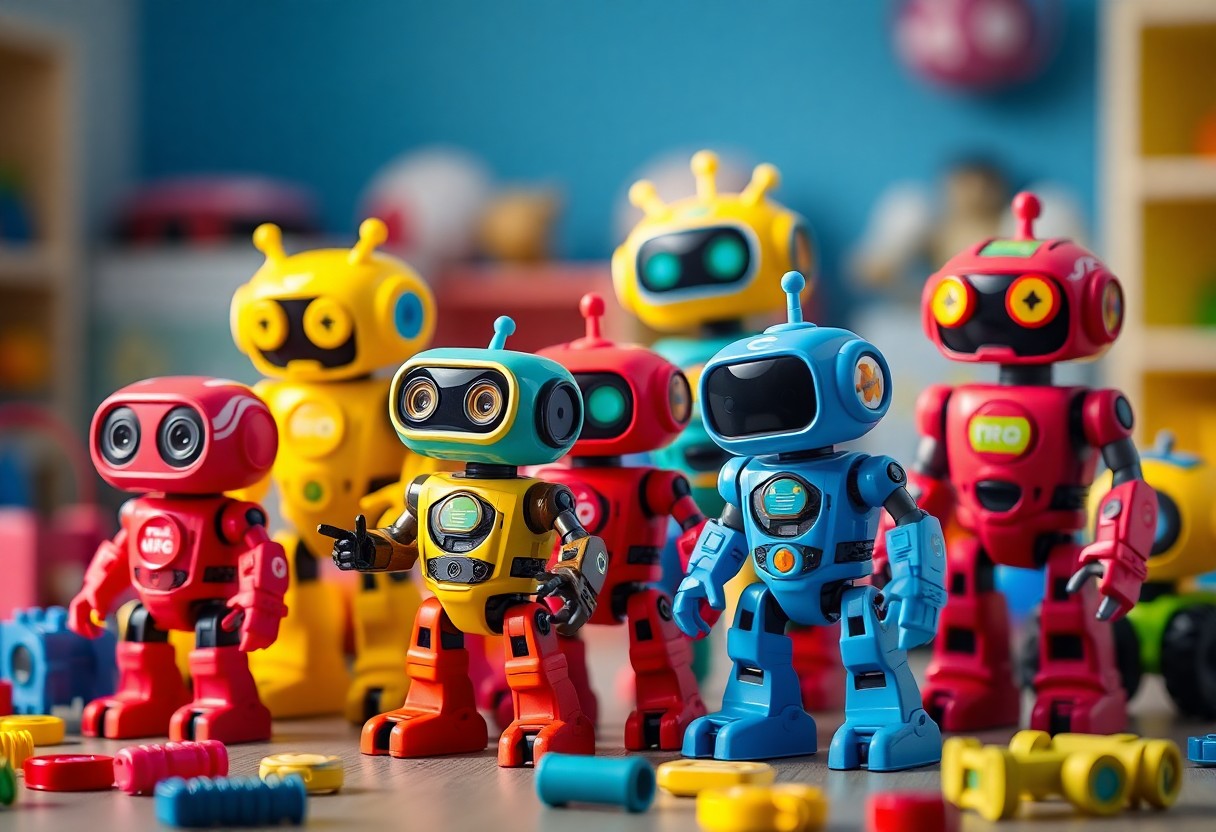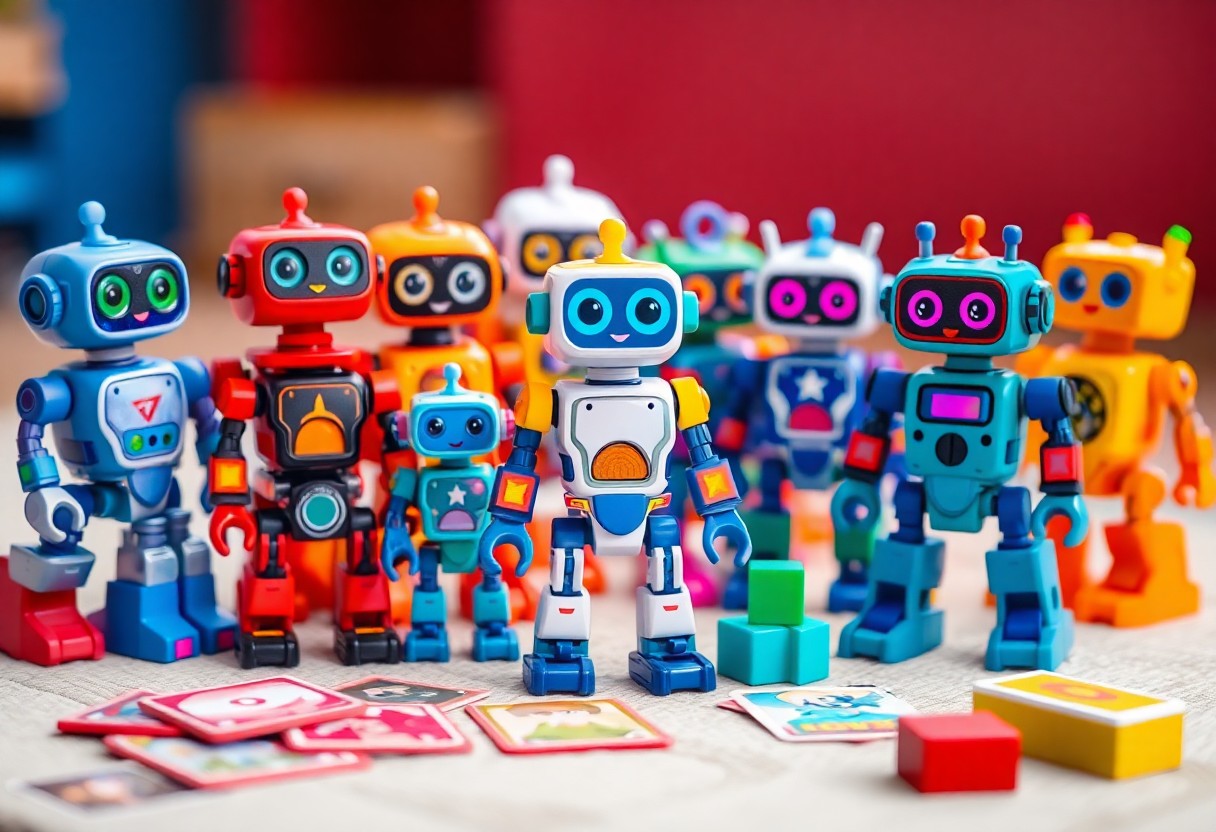Over the past few years, toy robots have transformed the landscape of play for children, merging entertainment with education in innovative ways. As you explore this exciting trend, you’ll discover how these interactive devices not only captivate your child’s imagination but also promote important skills like critical thinking, creativity, and teamwork. This guide will explore into the various benefits of toy robots, illuminating their role in shaping the future of play while fostering a love for science and technology in young minds.
Types of Toy Robots
For parents and children alike, toy robots come in various forms that enhance the play experience, each suited to different interests and learning outcomes. Below are some key types:
- Interactive Robots
- Programmable Robots
- Remote-Controlled Robots
- robotic Kits
- Educational Robots
Any of these robot types can inspire creativity and improve problem-solving skills in children.
| Type of Robot | Description |
|---|---|
| Interactive Robots | Robots that engage with children through conversation and movement. |
| Programmable Robots | Robots designed for children to create custom programs and tasks. |
| Remote-Controlled Robots | Robots that can be operated using handheld remotes or apps. |
| Robotic Kits | Build-your-own kits that encourage engineering and creativity. |
| Educational Robots | Focused on teaching concepts like coding and science through play. |
Interactive Robots
You will find interactive robots that engage your child through dialogue, music, and movement. These robots often have sensors that respond to touch and sound, allowing for engaging playtime experiences. They promote social skills and can serve as companions, making learning fun and interactive.
Programmable Robots
Types of programmable robots enable you to teach your child the basics of coding through hands-on experiences. Children can create custom sequences that allow the robot to perform specific commands, fostering logic and critical thinking skills.
Interactive experiences with programmable robots can inspire creativity as your child learns to think critically about planning and execution. These robots often come with user-friendly interfaces, making coding accessible even for young learners. By experimenting and troubleshooting, your child will develop crucial skills for the future.
Remote-Controlled Robots
On the other hand, remote-controlled robots provide an exhilarating form of play. You can control the robot’s movements and actions using a remote or mobile app, allowing for dynamic gameplay. This type of robot helps enhance hand-eye coordination and fine motor skills.
Programmable features in remote-controlled robots are becoming increasingly common, allowing you to set predetermined paths or actions for the robot to follow. This dual functionality not only provides engaging gameplay but also introduces programming concepts in an enjoyable manner, blending fun with education seamlessly.
Factors to Consider When Choosing Toy Robots
Even as you explore the world of toy robots, it’s imperative to evaluate several important factors to ensure a beneficial play experience. Consider the following:
- Age appropriateness
- Learning objectives
- Safety and materials
Any of these elements can significantly influence your child’s enjoyment and engagement with the toy robot.
Age Appropriateness
Factors such as your child’s age and developmental stage greatly influence the suitability of a toy robot for them. Selecting an age-appropriate robot ensures that the features and complexity align with your child’s abilities, enhancing their play experience and promoting learning.
Learning Objectives
For optimal development, it’s important to consider the learning objectives associated with a toy robot. Look for robots that foster skills such as coding, problem-solving, and creativity to enrich your child’s playtime.
For instance, many toy robots incorporate programming tasks that encourage logical reasoning, while others may focus on building social skills through interactive play. These varied learning objectives create a well-rounded play experience that supports your child’s growth.
Safety and Materials
If you want to ensure a safe play environment, it’s vital to evaluate the materials and construction of the toy robots. Look for products that are free from harmful substances and are designed with children’s safety in mind.
A reliable toy robot should be made from non-toxic materials and possess no small parts that could pose choking hazards. This focus on safety ensures that your child can engage with their toy robot without undue risk, allowing for worry-free playtime.
Tips for Enhancing Play with Toy Robots
To maximize the benefits of playtime with toy robots, consider the following strategies:
- Set up obstacle courses to challenge your child’s problem-solving skills.
- Integrate storytelling to give the robots personalities and adventures.
- Encourage coding and programming challenges for older children.
- Incorporate art supplies to personalize the toy robots.
The enhancements you bring to play with toy robots can significantly enrich your child’s experience.
Encouraging Creativity
You can enhance your child’s creative thinking by integrating art into their playtime. Provide them with basic craft supplies such as markers, stickers, and paint to decorate their toy robots. Encourage your child to create unique stories about their robots, imagining them in various roles and settings. This playful narrative can spark your child’s imagination, fostering their ability to think outside the box.
Fostering Collaborative Play
Play with toy robots can also serve as a platform for collaborative interaction. You can invite your child’s friends to join in, allowing them to work together on projects or challenges that involve their robots. This shared experience builds teamwork and communication skills while amplifying the fun.
With collaborative play, children learn to share ideas, negotiate roles, and support one another in problem-solving. By introducing group activities involving toy robots, you create an environment that emphasizes cooperation. This not only enhances social skills but also makes playtime more engaging and enriching for your child and their peers.
Step-by-Step Guide to Engaging with Toy Robots
Keep your child’s imagination running with these engaging steps to interact with toy robots. Follow this guide to make the most of their robotic experience:
| Step | Description |
|---|---|
| Setting Up the Robot | Prepare a suitable environment for your robot to operate effectively. |
| Exploring Features and Functions | Discover what your robot can do, from movement to sounds. |
| Creating Challenges and Activities | Encourage creative play by setting fun tasks for your robot. |
Setting Up the Robot
With a clean, safe space, position your robot free from obstacles. Ensure it’s fully charged or has fresh batteries, and introduce it to your child. This sets the stage for an enjoyable robotic adventure.
Exploring Features and Functions
Robots come with various features, including sensors, lights, and sounds. Guide your child to interact with each component, demonstrating how to operate buttons, connect apps, or program commands. This hands-on exploration enhances their understanding of technology.
Another way to engage is by allowing your child to experiment with programming the robot. They can create simple commands or sequences that will deepen their grasp of logical thinking and problem-solving while having fun discovering the robots’ capabilities.
Creating Challenges and Activities
Features such as obstacle courses or timed tasks can stimulate creative play. Encourage your child to think critically about how to maximize their robot’s capabilities in different scenarios.
With a range of potential activities, you can help your child design tasks that foster creative solutions. Whether it’s a race against the clock or navigating maze-like settings, these challenges will enhance both their engagement and learning experience.
Pros and Cons of Toy Robots
All toys come with their positives and negatives, and toy robots are no different. Understanding both sides can help you make informed decisions for your child’s playtime.
| Pros | Cons |
|---|---|
| Encourages STEM skills | Can be expensive |
| Enhances creativity | Potential screen dependence |
| Interactive learning experiences | Limited physical activity |
| Teaches problem-solving | May require batteries or charging |
| Customizable features | Not all models are user-friendly |
Advantages of Toy Robots in Play
For your child, toy robots offer a range of advantages that can enrich their play experience. These robots often encourage the development of STEM skills, boosting interest in science, technology, engineering, and mathematics at an early age. They also enhance creativity as children can program their robots or invent new games, fostering innovative thinking.
Potential Drawbacks of Toy Robots
Now, it’s important to consider the potential drawbacks of toy robots. While they can provide engaging play, some models may limit your child’s physical activity and promote a more sedentary lifestyle.
Robots can also be costly, which may not be feasible for every family. Additionally, many toy robots require batteries or charging, which adds ongoing maintenance challenges. Furthermore, some children may develop a reliance on screen-based interactions, limiting their engagement in more hands-on activities. Being aware of these drawbacks enables you to balance robotic play with other enriching experiences.
Conclusion
With this in mind, toy robots are not just playthings; they are reimagining how you and your children engage in learning and creativity. As technology evolves, these interactive companions offer unparalleled opportunities for development, fostering skills such as problem-solving and collaboration. By incorporating toy robots into your child’s playtime, you are investing in a future where play and education seamlessly merge, ensuring your child is well-prepared for the challenges of tomorrow’s world.






